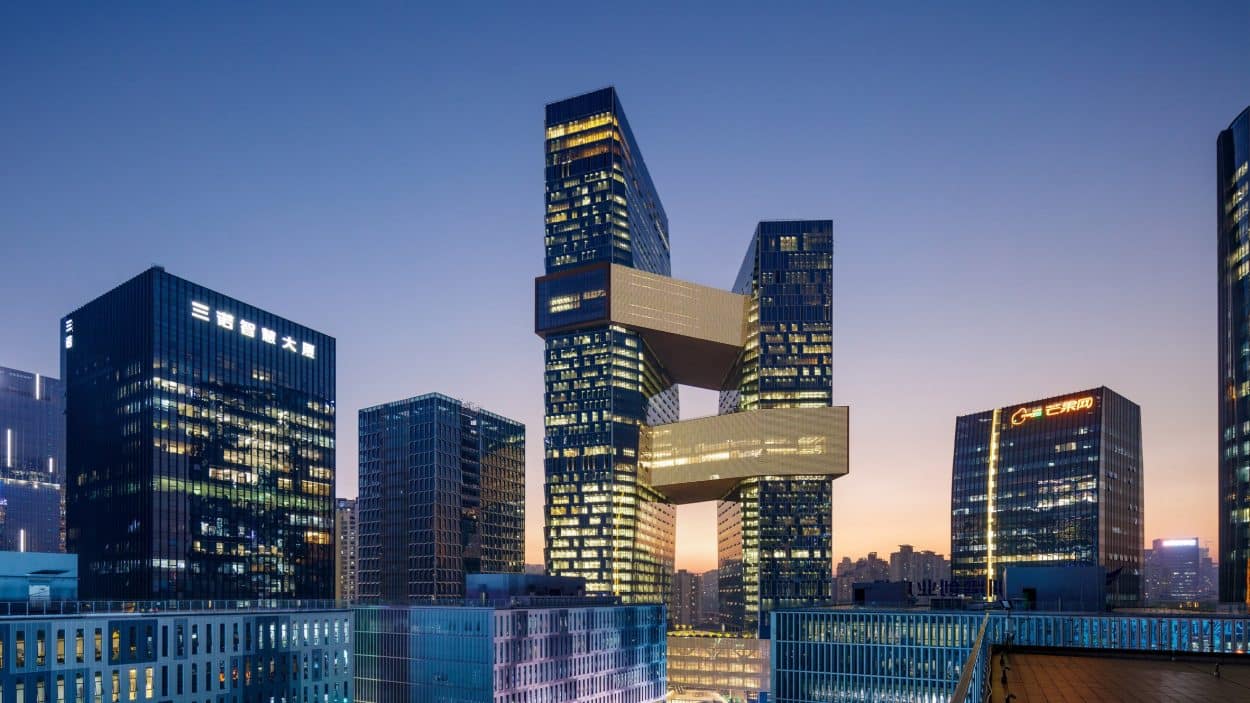American architecture firm NBBJ designed the global headquarters of Tencent, the company behind Chinese social media platform WeChat. It has since become an example of sustainability for the city of Shenzhen.
Since the twin towers of Tencent Binhai Building, the global headquarters for one of China’s leading technology companies, opened in Shenzhen’s high-tech district of Nanshan in late November 2017, its design standards for reducing energy consumption and absorbing the heavy rains that batter South China have become the gold standard for others to emulate here.
Over the past five years Tencent’s ability to monitor the energy consumption, carbon emissions and how well the building absorbs and reuses the rainwater that hits the headquarters and property through a smart city system developed by the company called Weiling has begun to accumulate massive amounts of data.
That data, the new lifeblood of the high-tech world, will assist Tencent in designing its own future facilities here in Shenzhen and other companies in their own project, further reducing carbon emissions, energy use and water consumption.
The Binhai headquarters, designed by NBBJ, an American global architecture, planning and design firm, along with input from Tencent’s internal architecture team, was designed along with China’s highest green building standards from the start.
Much of that includes how the building was sited geographically and shaped to conform to the elements, with windows placed to utilize daylight and reduce the amount of lighting needed during the day. The current daytime lighting, as well as the air conditioning system, is run by an AI system that automatically adjusts the lighting and temperature on each floor depending on the number of people on that floor.
WATCH: AIA Hong Kong Webinar: Tencent Seafront Towers by NBBJ; 16 juil. 2020.

“We don’t use many curtains, and don’t use much electricity in the lighting system,” Zeng Xianghong, Tencent senior solutions architect says to ArchiExpo e-Magazine on a visit to the building.
This includes how all the angles of the building and shading grill systems on the exterior of the building were designed to take advantage of the light and reduce the ambient heat created by the sun.
“We use as much natural light as possible, and tested angles to make sure the sunlight was factored in,” Zeng said. “Every space in the building is different.”
Besides meeting China’s highest green building standards, the facility has also been certified at the Gold level for LEED New Commercial Construction and Major Renovation Projects.
While the building is not carbon neutral, the design was made specifically to reduce energy use and carbon emissions, with those emissions reduced by around 40 percent.

Much of this was related to minimizing heat absorption on the exterior of the building and using the natural winds blowing from nearby Shenzhen Bay to cool the facility, thus reducing the overall need for intensive air conditioning. An outer layer of windows on the sunniest side includes a wind channel to reduce heat on the interior windows.
“When we designed the building we didn’t have the concept of carbon-neutral, but we tried to use materials that were as low carbon as possible and design the building to reduce carbon emissions as much as possible,” Zeng said.
Possibly one of the most impressive features ecologically are the “sponge city” elements incorporated into the building. Situated near the Tropic of Cancer, Shenzhen can have periods of intense rainfall as well as extended periods of drought.
The city just came out of one of its driest three-month periods since the early 1960s, but the ability of Tencent’s Binhai Building to collect rainwater on terraces and on porous ceramic tiles on the grounds surrounding it ensured there was enough water in storage to use during that period.
“We were able to still pull water from the storage system during the drought,” Zeng said.
Zeng claims that nearly 100 percent of the water that hits the property is collected, with the water funneled to both its own and municipal storage systems under the district that reduce flooding and allow for a reliable water supply during dry periods.

Most of the recycled water is used for watering vegetation on the property, with another 30 to 40 percent used for the toilet plumbing system. Besides this, heat from the large computer servers in the building is trapped and used to provide hot water in the faucets throughout the facility.
Watching all of this is the overseeing eye of the Weiling AI system, which monitors the performance of everything from the water collection to the lighting, air conditioning and total energy use of the building.
Through the data that is accumulating from monitoring this and other high-performance buildings that the Weiling system is being installed in, the company is better able to see what works best and where improvements need to be made.
Zeng says this will help with the design and construction of an even larger project called QQ Island or “Internet Plus Future Tech City”, a development along a strip of land reclaimed from the Pearl River Estuary near Shenzhen’s Bao’an International Airport which is currently under construction and is expected to be completed in the next five years.










